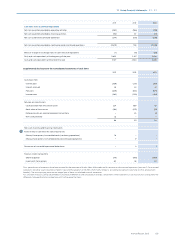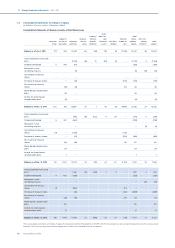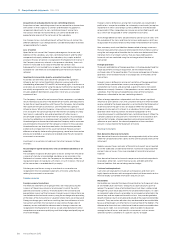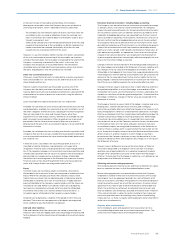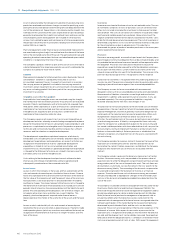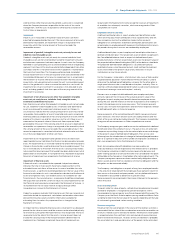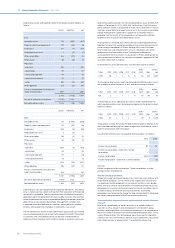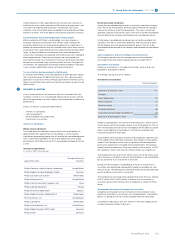Philips 2013 Annual Report Download - page 143
Download and view the complete annual report
Please find page 143 of the 2013 Philips annual report below. You can navigate through the pages in the report by either clicking on the pages listed below, or by using the keyword search tool below to find specific information within the annual report.
11 Group financial statements 11.9 - 11.9
Annual Report 2013 143
be refundable or deductible. Changes in tax rates are reflected in the
period when the change has been enacted or substantially-enacted by
the reporting date.
Discontinued operations and non-current assets held for sale
Non-current assets (disposal groups comprising assets and liabilities) that
are expected to be recovered primarily through sale rather than through
continuing use are classified as held for sale.
A discontinued operation is a component of an entity that either has been
disposed of, or that is classified as held for sale, and (a) represents a
separate major line of business or geographical area of operations; and (b)
is a part of a single coordinated plan to dispose of a separate major line of
business or geographical area of operations; or (c) is a subsidiary acquired
exclusively with a view to sell. A component that previously was held for
use will have one or more cash-generating units. Generally, the disposal of
a business that previously was part of a single cash-generating unit does
not qualify as a component of an entity and therefore shall not be
classified as a discontinued operation if disposed of.
Non-current assets held for sale and discontinued operations are carried
at the lower of carrying amount or fair value less costs to sell. Any gain or
loss from disposal of a business, together with the results of these
operations until the date of disposal, is reported separately as
discontinued operations. The financial information of discontinued
operations is excluded from the respective captions in the Consolidated
financial statements and related notes for all periods presented.
Comparatives in the balance sheet are not re-presented when a non-
current asset or disposal group is classified as held for sale. Comparatives
are restated for presentation of discontinued operations in the Statement
of cash flow and Statement of income.
Upon classification of a disposal group as held for sale the Company may
agree with the buyer to retain certain assets and liabilities, in which case
such items are not presented as part of assets/liabilities held for sale, even
though the associated item in the Statement of income would be
presented as part of discontinued operations. The presentation of cash
flows relating to such items in that case mirrors the classification in the
Statement of income, i.e. as cash flows from discontinued operations.
Adjustments in the current period to amounts previously presented in
discontinued operations that are directly related to the disposal of a
discontinued operation in a prior period are classified separately in
discontinued operations. Circumstances to which these adjustments may
relate include resolution of uncertainties that arise from the terms of the
disposal transaction, such as the resolution of a purchase price
adjustments and indemnifications, resolution of uncertainties that arise
from and are directly related to the operations of the component before its
disposal, such as environmental and product warranty obligations
retained by the Company, or the settlement of employee benefit plan
obligations provided that the settlement is directly related to the disposal
transaction.
Segments
Operating segments are components of the Company’s business activities
about which separate financial information is available that is evaluated
regularly by the chief operating decision maker (the Board of
Management of the Company). The Board of Management decides how to
allocate resources and assesses performance. Reportable segments
comprise the operating sectors Healthcare, Consumer Lifestyle and
Lighting. Innovation, Group & Services (IG&S) is a sector but not a separate
reportable segment and holds, amongst others, headquarters, overhead
and regional/country organization expenses. Segment accounting
policies are the same as the accounting policies as applied to the Group.
Cash flow statements
Cash flow statements are prepared using the indirect method. Cash flows
in foreign currencies have been translated into euros using the weighted
average rates of exchange for the periods involved. Cash flows from
derivative instruments that are accounted for as fair value hedges or cash
flow hedges are classified in the same category as the cash flows from the
hedged items. Cash flows from other derivative instruments are classified
consistent with the nature of the instrument.
Earnings per share
The Company presents basic and diluted earnings per share (EPS) data for
its common shares. Basic EPS is calculated by dividing the net income
attributable to shareholders of the Company by the weighted average
number of common shares outstanding during the period, adjusted for
own shares held. Diluted EPS is determined by adjusting the Statement of
income attributable to shareholders and the weighted average number of
common shares outstanding, adjusted for own shares held, for the eects
of all dilutive potential common shares, which comprise convertible
personnel debentures, restricted shares, performance shares and share
options granted to employees.
Financial guarantees
The Company recognizes a liability at the fair value of the obligation at the
inception of a financial guarantee contract. The guarantee is subsequently
measured at the higher of the best estimate of the obligation or the
amount initially recognized.
IFRS accounting standards adopted as from 2013
The accounting policies set out above have been applied consistently to
all periods presented in these Consolidated financial statements except as
explained below which addresses changes in accounting policies. In case
of the absence of explicit transition requirements for new accounting
pronouncements, the Company accounts for any change in accounting
principle retrospectively.
The Company has adopted the following new and amended IFRSs as of
January 1, 2013.
Disclosures - Osetting Financial Assets and Liabilities (Amendments to
IFRS 7)
As a result of the amendments to IFRS 7, the Company has expanded its
disclosures about the osetting of financial assets and liabilities. See
note 34, Fair value of financial assets and liabilities.
IFRS 10 Consolidated Financial Statements
IFRS 10 introduces a single control model to determine whether an
investee should be consolidated. The new standard includes guidance on
control with less than half of the voting rights (‘de facto’ control),
participating and protective voting rights and agent/principal
relationships. Based on a reassessment of the control conclusion for the
investees at January 1, 2013, the adoption of IFRS 10 did not have a
material impact on the Company’s Consolidated financial statements.
IFRS 11 Joint Arrangements
Under IFRS 11, the structure of the joint arrangement, although still an
important consideration, is no longer the main factor in determining the
type of joint arrangement and therefore the subsequent accounting.
Instead:
• The Company’s interest in a joint operation, which is an arrangement in
which the parties have rights to the assets and obligations for the
liabilities, will be accounted for on the basis of the Company’s interest
in those assets and liabilities.
• The Company’s interest in a joint venture, which is an arrangement in
which the parties have rights to the net assets, are equity-accounted.
Prior to 2012 the Company accounted for jointly controlled entities using
the equity method. The adoption therefore does not have a material
impact on the Company’s Consolidated financial statements.
IFRS 12 Disclosure of Interests in Other Entities
This standard contains the disclosure requirements for interests in
subsidiaries, joint ventures, associates and other unconsolidated
interests. As a result of IFRS 12, the Company has expanded its disclosures
on interests in other entities. See note 6, Interests in entities.
IFRS 13 Fair Value Measurement
IFRS 13 establishes a single framework for measuring fair value and making
disclosures about fair value measurements, when such measurements are
required or permitted by other IFRSs. More specifically, the definition of
fair value was clarified to be the price at which an orderly transaction to sell
an asset or to transfer a liability would take place between market
participants at the measurement date. The standard also replaces and
expands disclosure requirements about fair value measurements in other
IFRSs, of which some of these are required in interim financial statements
related to financial instruments. The Company therefore has included
additional disclosures in note 34, Fair value of financial assets and
liabilities. IFRS 13 has no material impact on the measurements of the
Company’s assets and liabilities.
Presentation of Items of Other Comprehensive Income (Amendments to
IAS 1)
The new amendment requires separation of items presented in Other
comprehensive income into two groups, based on whether or not they can
be recycled into the Statement of income in the future. Items that will not
be recycled in the future are presented separately from items that may be




